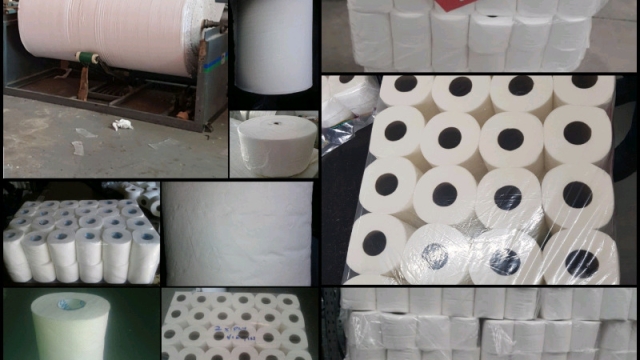In the fascinating world of manufacturing, there exists a product that often goes unnoticed, yet plays an essential role in our everyday lives – toilet paper. It’s a humble necessity that we rely on daily, but have you ever wondered about the intricate process that brings this indispensable item into existence? From the towering mills to the delicate finishing touches, let us embark on an illuminating journey behind the scenes of toilet paper manufacturing.
At its core, toilet paper manufacturing is a remarkable blend of science, technology, and expertise. It all begins with the carefully selected raw material – wood pulp. This natural fiber undergoes a series of complex steps, including pulping, beating, and pressing, to transform it into the fine paper base that we’re familiar with. This base is then skillfully processed and refined using water and various chemicals, resulting in a consistent and soft texture that we often take for granted.
But there’s more to the story than meets the eye. Achieving the perfect thickness, absorbency, and strength is an art in itself. This is where specialized machinery and advanced techniques come into play. Highly trained technicians carefully monitor each production stage, fine-tuning the parameters to ensure optimal performance and quality. From embossing patterns to perforations, every detail is meticulously crafted to enhance user experience and convenience.
As we delve deeper into the manufacturing process, we uncover the impressive speed and efficiency with which toilet paper is produced. Massive rolls of paper unwind rapidly, undergoing a myriad of transformations, ultimately resulting in thousands of neatly packed rolls that grace our supermarket shelves. The scale of operations required to meet the ever-growing demand for toilet paper is a testament to the industry’s commitment to delivering this essential product to households worldwide.
Join us as we unveil the secrets and intricacies behind toilet paper manufacturing. From the raw materials to the finished product, we’ll explore the science, the machinery, and the people who make it all possible. So next time you reach for a roll, spare a thought for the careful craftsmanship and attention to detail that went into creating it. Welcome to the extraordinary world of toilet paper manufacturing.
1. The Making of Toilet Paper
Toilet paper manufacturing involves several important steps. It all begins with the sourcing of quality paper materials. High-quality paper, usually made from wood pulp, is carefully selected to ensure strength and durability in the final product.
Once the paper is sourced, it goes through a process known as pulping. During pulping, the paper is mixed with water and chemicals to break it down into its individual fibers. This forms a slurry-like mixture which is then cleaned and refined to remove impurities.
Next comes the actual papermaking process. The refined pulp is mixed with water in a large vat to create a thin suspension. This mixture is then poured onto a wire mesh screen, allowing the water to drain and leaving behind a mat of wet fibers. As the water continues to drain, the fibers begin to bond together, forming a continuous sheet of paper.
Finally, the newly formed paper is pressed, dried, and rolled onto large spools. It may then undergo additional processes, such as embossing or perforating, to enhance the comfort and functionality of the final product. Once the paper has been transformed into rolls, it is ready to be packaged and distributed to stores, ready for the consumer.
And that is the remarkable process of toilet paper manufacturing. From sourcing the best materials to carefully crafting the finished product, each step ensures that we have reliable and comfortable toilet paper readily available for our everyday needs.
2. Key Ingredients and Manufacturing Process
Toilet paper manufacturing involves a simple yet crucial process that requires a few key ingredients. Let’s delve into the primary components and the manufacturing process behind this essential household item.
Pulp: The first ingredient in toilet paper manufacturing is pulp. Pulp is produced by processing wood chips or recycled paper fibers into a slurry. This slurry is then refined and cleaned to remove impurities, resulting in a smooth mixture ready for paper production.
Water: Water is another crucial ingredient used in the manufacturing process. It is mixed with the pulp to create a suspension, allowing the fibers to disperse evenly. The water also aids in the formation of the paper web during the manufacturing process.
Additives: Various additives are incorporated to enhance the functionality and quality of the toilet paper. These additives may include substances like starch, which can strengthen the paper and improve its absorbency. Additionally, softening agents are sometimes added to enhance the texture and comfort of the final product.

The manufacturing process of toilet paper relies on a combination of mechanical and chemical processes. Once the ingredients are prepared, the process typically involves the following steps:
Visit Website
First, the pulp is mixed with water to create a fiber suspension. This suspension is then refined further to ensure the fibers are properly dispersed and homogenous.
Next, the suspension is fed onto a large wire mesh belt. As the water drains away, the fibers start to bond together, forming a continuous sheet of paper. This sheet is then pressed to remove excess water and compact the fibers, making the paper stronger.
After pressing, the paper is dried through a series of heated rotating cylinders. This drying process removes the remaining water and sets the paper’s final dimensions.
Once dry, the paper is wound onto large rolls known as parent rolls. These parent rolls are then transported to cutting and packaging machines, where they are divided into more manageable sizes, typically household rolls.
In conclusion, toilet paper manufacturing involves a systematic process, utilizing key ingredients such as pulp and additives. The combination of mechanical and chemical processes ensures the production of high-quality toilet paper that fulfills its essential role in our daily lives.
3. Environmental Considerations in Toilet Paper Manufacturing
Toilet paper manufacturing is a complex process that requires careful consideration of its environmental impact. Companies in this industry are increasingly focusing on adopting sustainable practices to minimize their ecological footprint.
One key environmental consideration in toilet paper manufacturing is the sourcing of raw materials. Traditional toilet paper production usually relies on virgin wood pulp, obtained from cutting down trees. However, this approach contributes to deforestation and habitat loss. To address this issue, many manufacturers now opt for alternative sources of fiber, such as recycled paper or sustainably harvested bamboo. By using these materials, companies can help preserve forests and reduce their impact on ecosystems.
Another important aspect to be mindful of is the manufacturing process itself. Energy consumption and carbon emissions play a significant role in the environmental impact of toilet paper production. To mitigate this, manufacturers are implementing energy-efficient technologies and exploring renewable energy sources. By reducing energy consumption and transitioning to renewables like solar or wind power, these companies can decrease their carbon footprint and contribute to a cleaner future.
Waste management is a crucial consideration as well. Toilet paper production generates byproducts, including wastewater and solid waste. Ensuring proper treatment and disposal of these waste materials is essential to prevent pollution of water bodies and soil. Many manufacturers now invest in advanced wastewater treatment systems and recycling facilities to minimize their waste output and promote a circular economy.
The environmental considerations discussed here are just some of the ways in which the toilet paper manufacturing industry is striving towards sustainability. By embracing innovative solutions and adopting eco-friendly practices, companies can contribute to a healthier planet while continuing to meet the global demand for this essential hygiene product.



